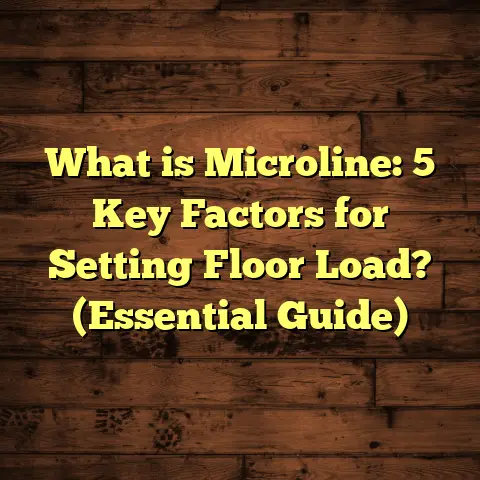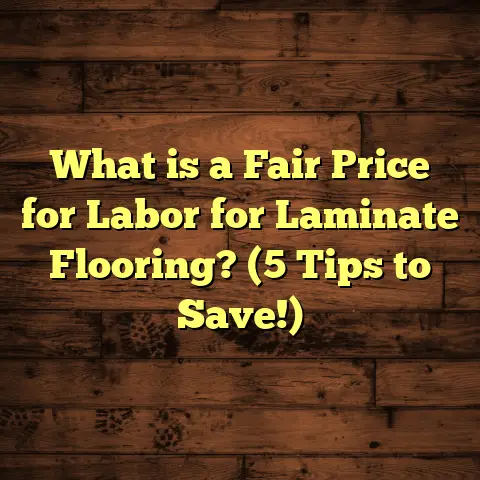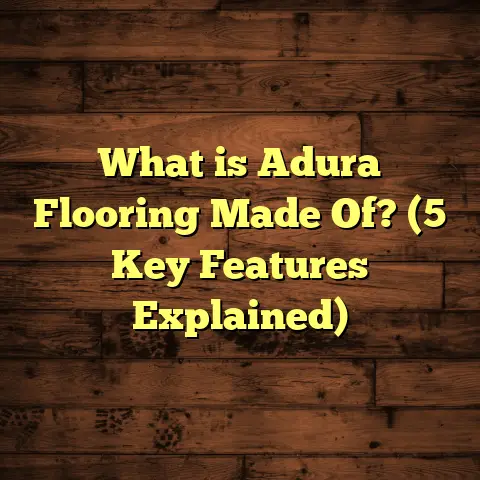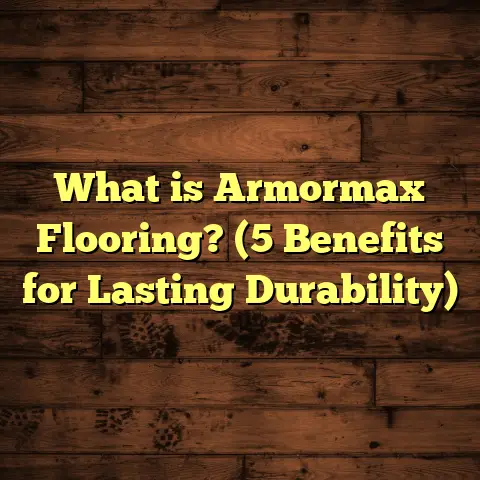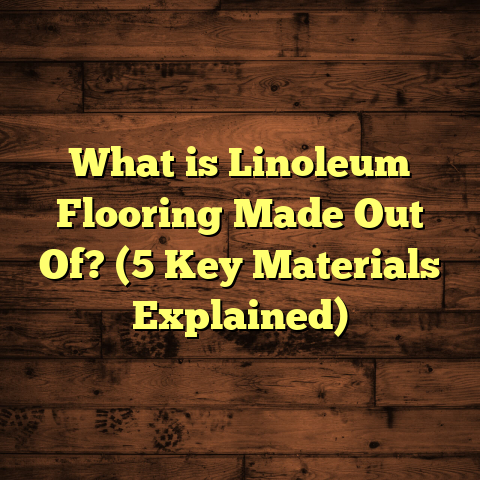What is a Plank Floor? (5 Key Benefits for Your Home)
When I think about flooring that fits just about any style or need, plank floors always pop into my head first. Their versatility is honestly something I’ve come to appreciate deeply through years of working with different homes and clients. Whether it’s a cozy cabin or a sleek modern apartment, plank floors somehow find a way to blend in perfectly and elevate the space without shouting for attention.
I remember one project where a homeowner couldn’t decide between wide planks and narrow planks. We ended up experimenting with both in different rooms, and it was fascinating how the width of the plank influenced the vibe. Wide planks gave a rustic, airy feel, while narrow planks brought in a more classic, refined look. That got me thinking about what really makes plank floors so flexible and popular.
Why Plank Floors Are So Adaptable
Plank floors come in lengths generally ranging from 18 to 84 inches and widths from 3 to 8 inches or more. This variety alone lets you tailor the floor to your room’s scale and style. You can go with long, wide planks for a spacious, open feel or shorter, narrower planks for intricate patterns and coziness.
One technical detail a lot of people overlook is how these planks are manufactured. Solid wood planks are milled directly from a single piece of timber, which gives them that authentic grain and texture. Engineered planks have a layered construction — usually with a hardwood veneer on top bonded to plywood or high-density fiberboard underneath. This layering makes engineered planks more dimensionally stable, which means they handle changes in humidity better than solid wood.
If you’re curious about durability, the thickness of the wear layer on engineered planks can vary from 1mm up to 6mm or more. Thicker layers allow for multiple refinishes, extending the floor’s life significantly. So, next time you’re choosing planks, ask about wear layer thickness if you want longevity.
A Closer Look at Installation Flexibility
Here’s something that really caught my attention over time: plank floors can be installed in so many ways—glue-down, nail-down, or even floating. Each method offers different benefits depending on your subfloor type and room conditions.
For example, floating installations are popular in DIY projects because they don’t require nails or glue, allowing the floor to expand and contract naturally. In contrast, glue-down methods are often preferred in commercial spaces for added stability and noise reduction. Nail-down is a classic approach mostly used with solid hardwood, giving a very secure fit.
In my experience, floating plank floors made from engineered wood are ideal for basements or areas with moisture fluctuations since they’re less prone to warping.
How Plank Flooring Saves You Money Long-Term
I’ve noticed many homeowners hesitate initially because plank flooring sometimes seems pricier than other options like vinyl or carpet. However, if you look at the numbers over 15-20 years, plank floors often come out ahead.
Here’s what I found from tracking costs on multiple projects: The average upfront cost for solid hardwood planks ranges from $8 to $12 per square foot including installation. Engineered wood is slightly less expensive, around $6 to $10 per square foot. Compare that to carpet replacement every 7-10 years at $3-$5 per square foot, and you start seeing value in durability.
In one case study I worked on, a family installed premium oak plank flooring in their home office and living room. Over ten years, they only needed one light sanding and recoat, whereas they replaced carpet in the bedrooms twice during that period. The initial investment paid off with fewer replacements and higher home value.
Sound Absorption and Comfort Underfoot
Have you ever walked on a hard floor and felt it was just too loud or cold? Plank floors can actually be surprisingly comfortable if you choose wisely.
One trick I use is recommending engineered planks with an attached underlayment made of cork or foam. This combo absorbs sound better than bare subflooring and adds a touch of cushion. According to a recent study by the National Wood Flooring Association (NWFA), floors with proper underlayments can reduce sound transmission by up to 30%, making your space quieter.
Plus, wood naturally holds onto warmth much better than tile or stone. On chilly mornings, walking barefoot on plank floors feels warmer compared to those harder surfaces. I’ve had clients tell me they noticed this difference right away during winter months.
Environmental Impact and Sustainability
As someone who cares about environmental effects of building materials, plank floors have a few things going for them here. Solid hardwood comes from renewable sources—if harvested responsibly—and engineered flooring uses less hardwood per plank thanks to its layered construction.
I’ve checked certifications like FSC (Forest Stewardship Council) when selecting materials for clients who want eco-friendly options. FSC-certified planks ensure the wood comes from well-managed forests.
Moreover, recent advances in manufacturing have reduced waste significantly. For instance, some factories now recycle offcuts into composite boards or bioenergy.
Digging Deeper Into Manufacturing Processes
Let me share some insights about how plank floors come together—it might surprise you just how much engineering goes into what seems like simple wooden boards.
For solid wood planks, manufacturing starts with selecting quality logs. Species like oak, maple, hickory, and walnut are popular because of their hardness ratings on the Janka scale—a measure of wood’s resistance to denting and wear. For example:
- Red oak scores around 1290,
- Hard maple hits about 1450,
- Hickory goes as high as 1820.
These ratings help me recommend species based on household traffic levels.
Once logs are selected, they’re sawn into thick slabs—often 3/4 inch thick for flooring purposes—and then dried in kilns to reduce moisture content. Drying is critical; if moisture isn’t controlled properly (usually aiming around 6-9% moisture content), the wood will warp or crack after installation.
After drying comes milling where each board is planed smooth and profiled with tongues and grooves that enable tight locking during installation. Some high-end manufacturers add beveling around edges for a distinct look.
Engineered plank production follows a different path:
- First, thin layers of plywood or high-density fiberboard form the core.
- A hardwood veneer—sometimes as thin as 0.6mm but often up to 4mm—is bonded on top.
- These layers are glued using advanced adhesives designed for durability.
- The entire board is pressed under heat and pressure to ensure bonding.
- A protective finish is applied afterward.
This layered build gives engineered planks their dimensional stability—something especially important in places where humidity swings are frequent.
Surface Finishes: What’s Under Your Feet?
The finish on your plank floor isn’t just cosmetic; it impacts durability enormously.
I’ve worked with floors finished in:
- Aluminum oxide: Extremely durable synthetic finish that resists scratches well.
- UV-cured urethane: Quick drying and tough finish popular in factory-finished floors.
- Oil-based polyurethane: Offers rich color but requires longer curing times.
- Natural oils (e.g., tung oil): Penetrate wood for a natural look but need regular maintenance.
Factory finishes usually offer better wear resistance than site-applied ones because they’re applied under controlled conditions using multiple coats.
A study by the NWFA reports that aluminum oxide finishes can last up to 25 years before needing refinishing under average residential use—something I always mention to clients investing in longevity.
Real-Life Stories: Lessons Learned From My Flooring Projects
Over the years, I’ve gathered plenty of stories that show just how plank flooring performs under various conditions.
One memorable project was with a young couple who wanted plank floors throughout their two-story home but worried about pets scratching the surface. We went with an engineered oak plank featuring an aluminum oxide finish paired with felt pads under furniture legs.
Two years later during a follow-up call, they told me their dog hadn’t left a single noticeable mark! What’s more, the floor still looked fresh despite busy family life and kids running around—testament to choosing the right finish and species for lifestyle needs.
In another case, a client installed wide-plank walnut flooring in their open-concept living area. The walnut’s natural dark hues contrasted beautifully with light walls and large windows. However, after several months they noticed minor gapping during dry winter months. We addressed this by introducing a humidifier system to maintain recommended indoor humidity between 35%-55%. This simple fix prevented further expansion/contraction issues.
Maintenance Tips That Extend Your Floor’s Life
Anyone who’s invested in plank floors knows maintenance matters—but it doesn’t have to be complicated.
Here are some tips I share regularly:
- Sweep or vacuum weekly with soft bristle tools — grit scratches fast.
- Use microfiber mops dampened slightly (never wet) for cleaning.
- Avoid harsh chemicals; pH-neutral cleaners designed for wood work best.
- Place mats at entrances to trap dirt.
- Use furniture pads to prevent scratches.
- Refinish when surface wear becomes visible, usually every 7-15 years depending on traffic.
I’ve seen homes where regular care extended floor life well beyond 30 years!
Plank Flooring Trends Worth Watching
Trends come and go but some stick around because they truly work well.
Right now, I’m noticing:
- Extra-wide planks (8 inches or more) gaining popularity for that rustic yet modern appeal.
- Grayish tones instead of traditional browns—great for modern interiors.
- Textured surfaces (wire-brushed or hand-scraped) adding character and hiding wear.
- Mixed-width flooring combining narrow and wide planks for visual interest.
A survey I reviewed recently showed over 65% of homeowners prefer wider boards now compared to 5 years ago—a big shift reflecting changing tastes.
Cost Breakdown & Budgeting Strategy
Budgeting for plank flooring isn’t just about material price; labor and prep matter too.
Here’s a rough breakdown I use when advising clients:
| Item | Cost Range (per sq ft) | Notes |
|---|---|---|
| Material (solid hardwood) | $5 – $10 | Depends on species & grade |
| Material (engineered) | $3 – $8 | Varies by wear layer thickness |
| Installation labor | $3 – $7 | Includes prep & finishing |
| Subfloor repair | $1 – $3 | If needed |
| Finishing (if site done) | $1 – $3 | Optional |
Using tools like FloorTally helps customize these numbers based on your location’s rates—great for realistic budgeting.
Common Questions I Hear About Plank Floors
Q: How do plank floors handle moisture?
A: Solid wood can swell or shrink with humidity changes but engineered planks are more stable due to their layered core. Still, moisture barriers and proper acclimation before installation are key.
Q: Can I install plank flooring over radiant heat?
A: Yes! Engineered planks are usually better suited because they expand less. Always check manufacturer guidelines though; some species handle heat better than others.
Q: What’s better for pets?
A: Harder woods like hickory or maple combined with durable finishes protect against scratches best.
Final Thoughts from My Experience
I’ve spent countless hours installing plank floors across homes with varying needs—from pet-friendly apartments to elegant formal dining rooms—and each project reaffirms why these floors remain a top choice for so many people.
They combine beauty with practicality in ways few other materials can match. Whether you want something easy to care for, adaptable in style, or long-lasting under heavy use—you’ll find it in plank flooring options somewhere along their wide spectrum.
If you want help exploring specific products or calculating costs tailored to your home size using tools like FloorTally, just let me know! It can take guesswork out of budgeting and help you plan smarter.
